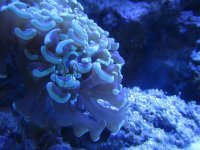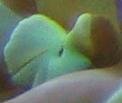Hi!
I got what seems to be a sort of parasite on my hammer (ancora) coral. I send you some pictures and give you some facts. I have search the internet, asked people locally, nobody can tell me what it is and how to get rid of it.
-The "parasite" looks like a white tangled ribbon 2 to 4mm in lenght. Sometimes elongated sometimes as a ball. Looks sedentary but does have some movement.
-They show mostly at night. If you look at it with a flashlight they sometimes retract and get back inside the polyp (within seconds). You can then see that the polyp is punctured. It leaves a 2mm hole in the tip. These corals heal quickly so you dont see those holes anymore during day except for the occasional black dot (a scar(?)).
-It is always located on the tip of the polyps, but anywere on the tip (on the "metallic green" part).
-The problem started on Aujust 15th but until today the coral still seems healthy except for a few deformed polyps (that were previously perfectly shaped).
-The Heteractis Crispa anemone about 12" away from the infected hammer coral started to have the same problem on september 16th. Again only on the (purple) tips. I noticed once that two tentacles were linked together by one of these ribbon like parasite. The parasite was longer than usual, probably by the pulling effect of the two tentacles.
-There is a branching hammer (paranchora) less than a foot from it but it is still not contaminated yet.
Thanks a lot in advance for your help!
Dominique
I got what seems to be a sort of parasite on my hammer (ancora) coral. I send you some pictures and give you some facts. I have search the internet, asked people locally, nobody can tell me what it is and how to get rid of it.
-The "parasite" looks like a white tangled ribbon 2 to 4mm in lenght. Sometimes elongated sometimes as a ball. Looks sedentary but does have some movement.
-They show mostly at night. If you look at it with a flashlight they sometimes retract and get back inside the polyp (within seconds). You can then see that the polyp is punctured. It leaves a 2mm hole in the tip. These corals heal quickly so you dont see those holes anymore during day except for the occasional black dot (a scar(?)).
-It is always located on the tip of the polyps, but anywere on the tip (on the "metallic green" part).
-The problem started on Aujust 15th but until today the coral still seems healthy except for a few deformed polyps (that were previously perfectly shaped).
-The Heteractis Crispa anemone about 12" away from the infected hammer coral started to have the same problem on september 16th. Again only on the (purple) tips. I noticed once that two tentacles were linked together by one of these ribbon like parasite. The parasite was longer than usual, probably by the pulling effect of the two tentacles.
-There is a branching hammer (paranchora) less than a foot from it but it is still not contaminated yet.
Thanks a lot in advance for your help!
Dominique








